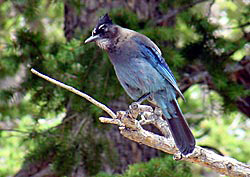
Climate change has California’s birds on the move, but not in the usual direction or at the same pace, a new study has found. Research suggests that warming temperatures and changing precipitation patterns will cause bird species distributions to shift independently, resulting in new bird “communities” appearing in up to half the state.
In some cases, these new communities will create combinations of birds that have never existed before, a situation that could disrupt the delicate balance of species interactions with potentially unanticipated consequences for whole ecosystems, the report authors concluded.
One of the co-authors, Stanford biologist Terry Root, told Climate Watch: “This will not be just a few species in a few locations–this tearing apart of communities could be quite extensive across California.”
Root was among researchers from Stanford’s Woods Institute for the Environment, PRBO Conservation Science, the University of California-Santa Cruz, and the Klamath Bird Observatory, who collaborated on the study. They used bird survey data and climate model projections for California to map current and future bird distributions for 70 species. Many species often found together, such as acorn woodpeckers and western bluebirds, are projected to shift and adapt in different ways, resulting in these new assemblages.
PBRO has posted interactive maps of the future projections for individual species distributions on its Climate Change, Birds, and Conservation website, in the section called “Where will the birds be?“.
The study authors, including Terry Root of Stanford and Diana Stralberg and John Wiens of PRBO, write that the emergence of new bird communities in the coming decades present enormous conservation and management challenges. They assert that rapidly changing habitats and ecological communities are going to require new approaches to conservation and management. “As new combinations of species interact, some species will face new competition and/or predation pressures, while others may be released from previous biotic interactions,” they wrote. “Managers and conservationists will be faced with difficult choices about how, where, and on which species to prioritize their efforts and investments.”
Root pointed to experience with wolves, coyotes and foxes, in which wildlife managers tried to control one, only to see unexpected spikes in the population of another: “Here is a community of only 3 canines to which we purposely forced changes, and we had two big surprises. Now we are talking about 70 species of birds shifting without any control of the force or the species being changed. I guarantee there will be a lot of surprises.”
